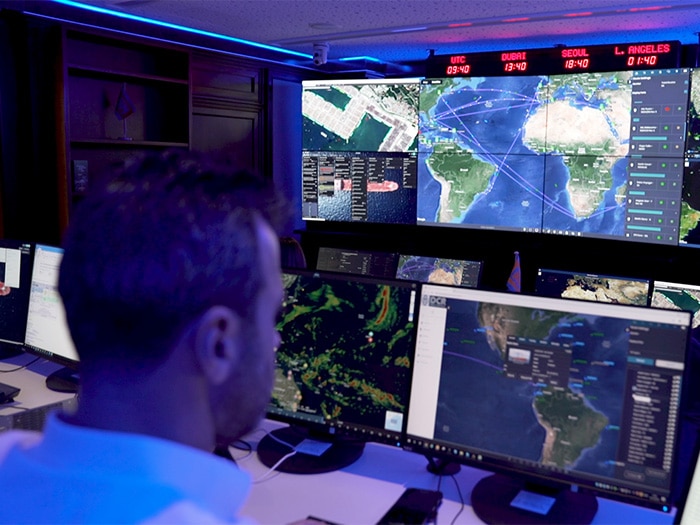
Columbia takes vessel digital twinning to the next level
Written by Nick Blenkey
CSM’s Port Optimization Control Room
Columbia Shipmanagement (CSM) is again aiming to push industry boundaries by creating a totally SMART and fully digitized “twin” of a jack-up barge under its management. The project is as part of a digital twinning process designed to massively optimize vessel performance.
The digital vessel twinning process was undertaken by the team at Columbia’s Performance Optimization Control Room (POCR) headed up by Captain Pankaj Sharma.
Using non-invasive next generation Internet of Things technology via a wireless eco-system with full machine learning capability, the connected vessel benefited from machinery health monitoring as well as enhanced engine diagnostics.
Transforming the SMART vessel into an effective digital twin, the process was one step ahead of pre-existing, often fragmented, ship-to-shore connectivity solutions.
What makes it a SMART vessel? According to Captain Sharma, it is as much about maximising IoT technology and minimising human input as it is about focusing on Artificial intelligence for predictive applications.
“The vessel is fully digitized and digitalized in a totally cyber secure environment. SMART cameras onboard the ship take analog images of the systems that are then digitized,” says Captain Sharma. “By combining and analyzing data from the sensors, the crew and the onshore technical department have direct access to all information about the health of specific items of equipment. The smart vessel solution capitalizes on the machine learning, self-correcting and early warning systems for asset preservation and the solutions are scalable, modular and OEM agnostic,” he said.
With sensor technology and data processing, the vessel uses advanced analytic techniques to identify data trends and anomalies, providing early indicators to avoid potential failures or downtime and help with decision making for crew and shoreside personnel. By using non-invasive sensors, the smart system on the vessel looks for any anomalies while monitoring the vessel’s diagnostics and predictive warning systems.
The mix of technologies onboard the vessel has a proven track record in the aviation, wind energy and marine industries.
Optimizing engine and vessel performance through the ingenuity of the POCR can help to reduce emissions as well as increase the life of equipment onboard ship, boosting the return on investment for the owner as well as providing accurate equipment maintenance and condition records which can help to boost a vessel’s resale value. It can also reduce fuel consumption by between 2% and 5% as well as generate other benefits such as reduced dry docking costs; improved insurance rates and the potential for near zero down time of the vessel. Optimizing lubrication can also reduce vessel by vessel lubrication costs by up to 45%.
“While vibration and temperature monitoring have been used successfully on ships for many years to reduce breakdowns and improve equipment functionality and reliability, our vessel links sensor data to an onboard server from which the crew can immediately spot any abnormalities or problems,” says Captain Sharma. “The generator condition monitoring technology installed onboard, for instance, constantly takes measurements and can recognise abnormalities in the generators as well as the engines and gearboxes.”
Mark O’Neil, president and CEO of Columbia Shipmanagement, said: “I am very proud that our POCR has been designed by the experts at CSM with our clients’ needs at the forefront of our minds. Our POCR optimizes all areas of vessel operation, maintenance, bunker and lube oil purchase/consumption. This is monitoring and performance optimization at scales never before seen in our industry. We are proud to deliver this service to our customers Saudi Aramco and BGMS who are driving change and demanding efficiencies and levels of optimization and safety which were previously thought impossible to achieve. Welcome to the future of vessel/asset management.”




